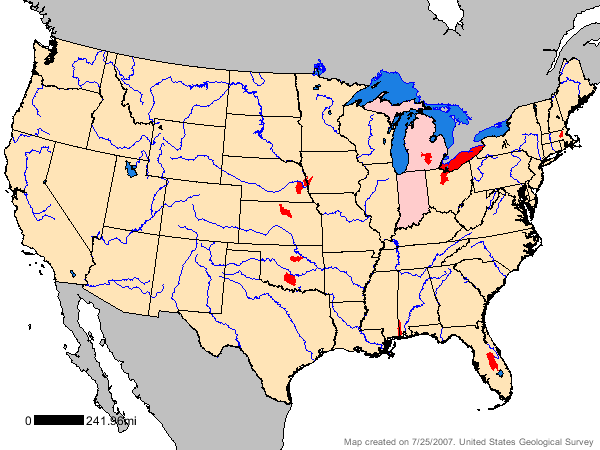
Habitat
The habitat for the Japanese mystery snail is freshwater
lakes and rivers. This species is also found in ditches,
either irrigation or roadside, and slow running portions of
streams (The Oregon Conservation
Strategy, 2011). Water depth is 4m or less with a high temperature
of 30 degrees C and a low of 16 degrees C (Kipp,
2007). The Japanese
mystery snail thrives in mud which is why in Japan it is often
found in rice paddies. Marsh like areas are common
locations for the species in the United States(Kipp,
2007).
 Cipangopaludina
japonica is native to Southeast Asia, specifically Japan.
This specific Japanese Mystery Snail species has also been located in Taiwan and Korea
(The Oregon Conservation Strategy, 2011). It was
first introduced in 1890 to North America occurred when it was
imported to an Asian food market on the West Coast (Dillon,
2006). The
species was first found in Lake Erie in the 1940's where it was
used as food for catfish (Burch, 1980). The introduction to the Great
Lakes was intentional. Japanese mystery snails were
discovered near Green Bay in Lake Michigan in 1968 (Burch,
1980). It is
considered "established" in the United States. The species
has been reported in Massachusetts, Maryland, Virginia, North
Carolina, South Carolina, Georgia, Florida, Mississippi, Ohio,
Michigan, Oklahoma, Kansas, Nebraska, Minnesota, California, and
Wisconsin.
Cipangopaludina
japonica is native to Southeast Asia, specifically Japan.
This specific Japanese Mystery Snail species has also been located in Taiwan and Korea
(The Oregon Conservation Strategy, 2011). It was
first introduced in 1890 to North America occurred when it was
imported to an Asian food market on the West Coast (Dillon,
2006). The
species was first found in Lake Erie in the 1940's where it was
used as food for catfish (Burch, 1980). The introduction to the Great
Lakes was intentional. Japanese mystery snails were
discovered near Green Bay in Lake Michigan in 1968 (Burch,
1980). It is
considered "established" in the United States. The species
has been reported in Massachusetts, Maryland, Virginia, North
Carolina, South Carolina, Georgia, Florida, Mississippi, Ohio,
Michigan, Oklahoma, Kansas, Nebraska, Minnesota, California, and
Wisconsin.
In Wisconsin, the Japanese mystery snail has been collected and
classified as established in three counties. In 2007 in
Barron County, Rice Lake; in Douglas County, St. Croix Flowage;
and in Washburn County, the Trego Flowage had
Cipangopaludina japonica present (Kipp,
2007). In this above
mentioned St. Croix River Flowage in Wisconsin, the
Cipangopaludina japonica was found at six sites along the
Namekagon River (Bury, 2007).
Next, find out information about Ways of Life!
